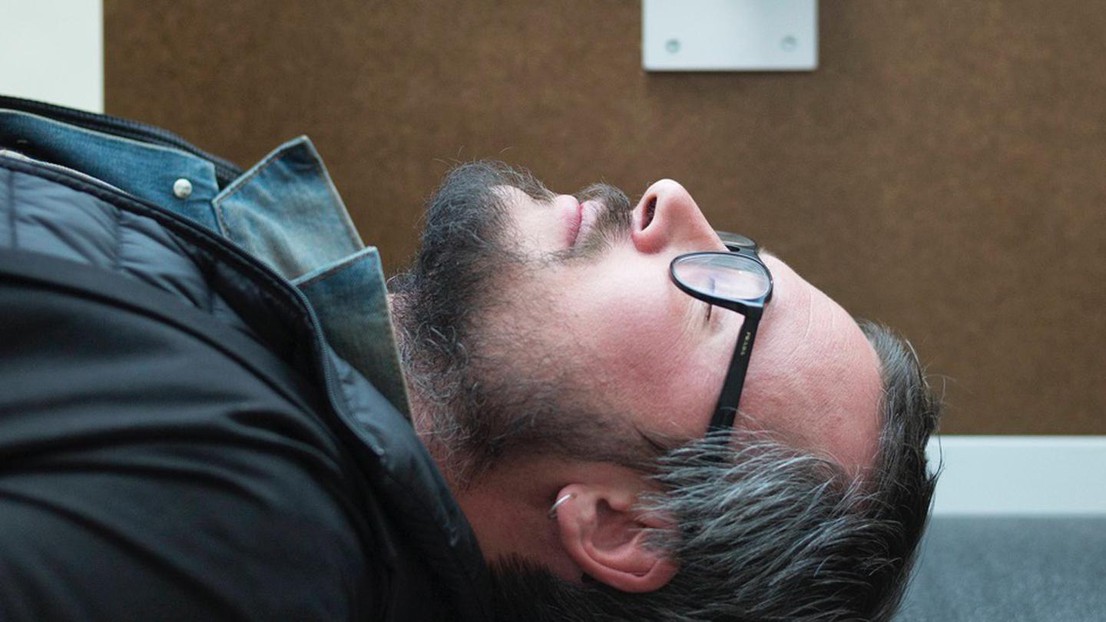Art exhibition explores our interactions with objects and machines

Portrait Luc Mattenberger ©photo© Christian Hartmann Carre
Geneva-based artist Luc Mattenberger creates work focused on brain function, machine learning, and the wellness industry. For CDH’s Les Culturelles, he will exhibit a series of sculptures and create a performance piece.
The exhibit “Be Fluid” will take place from 14 to 16 May (11h-18h), with performance on 14 May at 18h30. This project is based, in an experimental, questioning, and original way, on one of the priority research areas at EPFL: health.
“I called the exhibition ‘Be Fluid’ like the motto ‘go with the flow’,” Mattenberger says. “It's a bit of a cliché, but I think we're at a key moment in terms of our interactions with objects and machines that are tending towards a certain autonomy, or at any rate have processes that are becoming too complex for the average person to understand, even for those who programmed them.”
It will feature three moving sculptures, along with other works, that relate to wellness and transhumanism, as well as considering the perception of the viewer: Fontaine, Peanut Ball, and Up-Down.
Fontaine, created in 2022, is an illuminated plexiglass column from which water continuously overflows, inviting viewers to observe the water’s path and enter a trance-like state. Peanut Ball, created especially for this exhibition, consists of a gym ball encased in a tubular steel structure with a jack that presses one side at regular intervals, potentially inciting emotions in viewers on behalf of the ball being “mistreated” by the electric jack. With Up-Down, Mattenberger provides a stool where viewers can sit, behind which is a column with an aluminum panel where two concentric black circles move two directions, according to a choreography coded by a computer. For this sculpture, Mattenberger is interested in where the focus of the viewers goes.
“My point of entry into this interest with machines was the internal combustion engine. This led me to become more interested in the interactions between brain and machine, and also to think of the brain as a machine itself. Ultimately, we still have a quite rudimentary understanding of the brain. We understand brain function relatively well, but there are still many unknowns about its plasticity, its development, in the areas that are activated, and in the compensation processes when there is damage to the brain. Here is where I find the connection with artistic questions, because we are dealing with questions of perception and about holding a mirror up to the world.”
The performance for Be Fluid was created in collaboration with Basel-based musician and composer Christoph Huber and is based on EEG recordings of the brain activity of University of Basel researcher Dr. Reto Odermatt and Mattenberger during sensory stimulation and deprivation experiments. The performance will include the three sculptures and feature generative music and sound activations for each one.
With his interest in perception and how the brain function, Mattenberger infuses his work with research. He has had the opportunity to train with a psychotherapist who does hypnosis and who had started doing hypnosis for children with severe burns and has also spent a lot of time learning about the technique of Mindfulness-Based Stress Reduction (MBSR). He’s even experimented on himself when he was at a residency in Marfa, Texas.
“I said to myself, ‘I'm going to try to use myself a bit more like a lab rat.’ I had a playlist of different songs that had been listed as being used at Guantanamo for torture purposes and I decided that for the entire duration of my stay in America, I wouldn’t play anything else on my car radio except this playlist. And every night, I would drive down towards Mexico listening to that playlist for a month-and-a-half.”
While Mattenberger is interested in how people perceive his work, he recognizes the fact that he will of course never know what people experience when they experience his pieces.
“I am quite curious to see the reception of this work in this context, which is nevertheless different from a context perhaps more of an artistic space or institution. And to see the experience that the scientists and researchers at EPFL have. Maybe it will be critical, so much the better, because art is above all a territory for debate, aesthetic research and experience, and this is what makes it unique.”